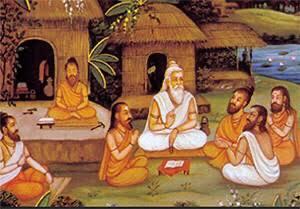Sri Gurubhyo Namah:
In the Bhagavad Gita, Sri Krishna says,
आर्तो जिज्ञासुरर्थार्थी ज्ञानी च भरतर्षभ |
Aartho jignaasurarthaarthi gnyaani cha bharatharshabha |
Sri Krishna talks about four kinds of people who seek refuge in Him — one who is in distress, one who is inquisitive, one who desires material wealth, and one who seeks Absolute knowledge. While anyone engaged in any of the above pursuits requires effective mentoring to achieve their goals, a person aspiring to become a gnyaani needs to definitely seek the lotus feet of a Guru or Achaarya (one who puts his teachings into exemplary action).
Sanathana Dharma has no one pravakta (preacher) or emissary. In this great land, there have been many seers who, by the sheer dint of their penance, could see the true nature of creation that is beyond sensory perception. These seers are hence called Drsthaas or Rishis. This extrasensory knowledge has been handed over generations since the dawn of creation through an inextricable system called the Guru-Sishya parampara.
Hence, the Guru occupies a position of vital importance in Sanathana Dharma.
A Guru is not a mere teacher
There are many etymologies for the word, “Guru”. The Guru Gita, which is part of the Skaanda Purana, explains several such meanings. In this sloka told by Sri Maheswara to Uma Devi,
गुकारश्चान्धकारो हि रुकारस्तेज उच्यते।
अज्ञानग्रासकं ब्रह्म गुरुरेव न संशयः ||
Gukaaraschaandhakaaro hi rukaarasteja uchyathe |
Agnyaanagraasakam brahma gurureva na samshayah: ||
The “Gu” in the word Guru signifies agnyaana or ignorance while “Ru” signifies light in the form of gnyaana or enlightenment. A Guru is undoubtedly one who dispels agnyaana by imparting knowledge of the Brahman.
In Sanathana Dharma, a Guru is not merely a person but is verily the parampara (lineage) Himself. A Guru is invoked in several ways before starting a prayer, study, or any other auspicious task. For instance,
नारायण समारम्भाम व्यास शंकर मध्यमाम् |
अस्मद् आचार्य पर्यन्ताम् वंदे गुरु परम्पराम् ||
Naarayana samaarambhaam vyasa shankara madhyamaam |
Asmad aacharya paryantaam vande guru paramparaam ||
(or)
सदाशिव समारम्भाम् शंकराचार्य मध्यमाम् |
अस्मद् आचार्य पर्यन्ताम् वंदे गुरु परम्पराम् ||
Sadaashiva samaarambhaam shankaraacharya madhyamaam |
Asmad aacharya paryantaam vande guru paramparaam ||
The invocation may change depending on one’s sampradaya, but the most important aspect here is that Sanathana Dharma is the only philosophy that considers God as a Guru and starts the lineage from Him.
Although all forms of Eswara are indeed Guru swarupas, there are forms which explicitly propound Guru tatvam (nature).
For example, Sri Maha Vishnu is worshipped as Hayagriva (Aadharam sarva vidyaanaam Hayagrivam upasmahe), Sri Maheswara is worshipped as Dakshinaa Murthy (Nidhaye sarva vidyaanam Dakshinaa Murthaye Namaha), and Devi is adored as Guru Mandala Roopini.
A spiritual aspirant must take cognizance of this fact and do Guru sushrusha (servitude to a Guru), which is indifferent from serving God.
Importance of the Guru in Kali Yuga
While a Guru’s need is not bound by the nature of time, the present age of Kali deserves a special mention. In all other yugas or epochs, demonic traits are personified. We read many instances of fighting between Devas and Asuras in the Puranas, and how ultimately Devas win because Dharma is on their side. In Kali Yuga, Asuras do not have a separate upaadhi (body). Instead, they reside within the heart of ordinary humans and provoke tamasic (mode of darkness or ignorance) traits from within.
In all other yugas, Eswara has taken different forms to vanquish evil. These forms are referred to as Avataaras (taara – an exalted state, avataara – a form that is more accessible). Since Aasuric traits had a distinct upaadhi in all these yugas, they could be easily vanquished. In Kali, Aasuric traits such as excess of kaama (desire), krodha (anger), lobha (greed), moha (attachment), mada (pride), and maatsarya (jealousy), also referred to as arishad vargas (six enemies), are present in almost every human being. If Eswara has to vanquish everyone for this reason, there would only be a handful of people left on this earth. This is where a Guru’s role becomes paramount.
Role of a Guru in emancipating a seeker
In this age, the only viable alternative for vanquishing these Aasuric tendencies from the heart of people and make them tread the Dharmic path is to impart knowledge. A seeker who surrenders to a Guru can overcome these arishad vargas by continued saadhana (effort).
Vidya or education primarily serves two purposes — worldly living and spiritual upliftment. While we are familiar about the trials and tribulations needed for worldly success, only a Guru can help in spiritual upliftment by helping the seeker excel in three important stages — Dharma (duty), Upaasana (study), and Gnyaana (Absolute Knowledge). A Guru’s treatment of His disciple is rightly called vaatsalya, likening it to the kind of love a cow shows towards its calf (vatsa). Just like how a cow, which does not remotely touch meat even under starvation, happily licks off the placental covering on the newborn calf, a Guru cleans the seeker’s sins acquired over many births and makes him His own. There are only three entities who can show such vaatsalya — a cow to its calf, a Guru to His disciple, and Paramatma to the jiva.
Every person is unique and has his/her own view of the world depending on their upbringing, peer relations, mindset, and purva janma vaasanas (traits carried forward from their previous lives). While some advocate rituals, some prefer inward contemplation while others prefer social service. Some have inclination towards certain forms of Eswara (saguna) while others believe in formless and attribute-less (nirguna) worship. No matter the seeker’s thought process, a Guru only looks into imparting gnyaana. The only criterion is that the seeker should have unflinching devotion, not for the Guru’s pleasure but for his own spiritual progress.
The beauty of Sanathana Dharma is that it provides an equal opportunity for everyone irrespective of their paths. It is like a string that is hidden in a garland made of a variety of flowers. We see only the flowers but without the string, the flowers cannot be held together.
An often-asked question is how long a person should be under a Guru’s guidance. Unlike mundane education, aadhyatmika saadhana (spiritual endeavor) is not a curriculum. The Guru’s guidance continues till the seeker has realized his true nature. Sri Krishna stopped imparting the knowledge of the Gita only when Arjuna said,
नष्टो मोह: स्मृतिर्लब्धा त्वत्प्रसादान्मयाच्युत |
स्थितोऽस्मि गतसन्देह: करिष्ये वचनं तव ||
Nashto mohah: smrutir labdhaa tvatprasaadaanmayaachyuta |
Sthithosmi gatasandehah: karishye vachanam tava ||
Oh Achyutha! By your grace, my illusion has been dispelled, and I have attained realization. I am now free of doubts and will do your bidding.
This is the state of realization. Until one reaches this, the Guru’s lotus feet are the only refuge.
अनंत संसार समुद्र तार नौकायिताभ्यां गुरुभक्तिदाभ्यां।
वैराग्य साम्राज्यद पूजनाभ्यां नमो नमः श्री गुरु पादुकाभ्यां॥
Anantha samsara samudra taara naukaayitaabhyaam gurubhaktidaabhyam |
Vairaagya saamrajyada pujanaabhyaam namo namah: Sri Guru Paadukaabhyam ||
Salutations to the sandals of my Guru, which are like a boat to help me cross the ocean of life, which give me devotion to my Guru, and which help me rule over the kingdom of renunciation.
Author: Vaidyanathan Subramaniam
Vaidyanathan is a cell and molecular biologist based in Bengaluru. His interests include Dharma Sastras, new therapeutics for rare diseases, and consumer and enterprise technology among many others.
























 WhatsApp us
WhatsApp us
Pingback: kalpa pharma testosterone
Pingback: kalpa pharma steroid review
Pingback: cbd oil for insomnia
Pingback: 메이저놀이터
Pingback: buy/order Mountain High Suckers Lollipops Edibles online use for pain, anxiety, sleep for sale near me bulk in usa uk nz canada australia overnight delivery
Pingback: airport transfer cheltenham
Pingback: pinewswire.net
Pingback: 안전공원
Pingback: DevOps
Pingback: human hair wigs
Pingback: buy ruger long guns online
Pingback: 사설토토
Pingback: kids swimming
Pingback: Regression Testing
Pingback: https://www.bestswisswatch.cc/
Pingback: sexy club outfits for women party club night shorts
Pingback: omega de ville replica 424 20 37 20 03 002 blue dial 36 8mm
Pingback: Villas Near Hyderabad Outer Ring Road for Outright Sale
Pingback: tramadol online
Pingback: keto dinner
Pingback: buy cc dumps
Pingback: single gay dads dating
Pingback: swiss replica cartier
Pingback: 셔츠룸
Pingback: sap concur test drive
Pingback: sbo
Pingback: Firearms For Sale
Pingback: cornhole wrap
Pingback: snuscore de
Pingback: find more here
Pingback: second brain template
Pingback: sbo
Pingback: click now
Pingback: Investing in the stock market
Pingback: passive income ideas